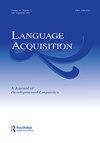English-learning preschoolers can correctly parse and interpret negative sentences to guide their interpretations of novel noun and verb meanings
IF 1.3
3区 文学
0 LANGUAGE & LINGUISTICS
引用次数: 0
Abstract
ABSTRACT We studied English-learning children’s ability to learn the meanings of novel words from sentences containing truth-functional negation (Exp1) and to use the semantics of negation to inform word meaning (Exp2). In Exp1, 22-month-olds (n = 21) heard dialogues introducing a novel verb in either negative-transitive (“Mary didn’t blick the baby”) or negative-intransitive (“Mary didn’t blick”) sentences. When then asked to “Find blicking!” while viewing two-participant versus one-participant actions, children who heard negative-transitive sentences looked longer at the two-participant event than children who heard negative-intransitives. Thus, the mere presence of negation does not disrupt sentence processing and word learning in young children. Experiment 2 tested whether 2-to-4-year-olds (n = 20) use the semantics of negation to restrict the meaning of novel nouns when categorizing objects varying along a perceptual continuum (from 10 to 90% exemplars). Children initially heard “These are blickets” paired with certain exemplars (e.g., yellowish creatures, exemplars 10 and 30%). They then saw additional exemplars (e.g., pinkish creatures, 70 and 90%) while hearing either “These are not blickets” (negative condition) or “These are also blickets” (affirmative condition). At test, when seeing two novel exemplars from the continuum (e.g., creatures 20 and 80%) and asked to find “a blicket,” children in the negative condition selected the exemplar from the bottom of the continuum (i.e., the 20%) more often than children in the affirmative condition. Thus, English-learning children as young as 22-months of age correctly parse negative sentences and 2-to-4-year-olds can use negation to understand the boundaries of a word’s meaning.学习英语的学龄前儿童可以正确地解析和解释否定句,以指导他们对新名词和动词含义的解释
摘要:我们研究了英语学习儿童从含有真功能否定的句子中学习新单词的意义的能力(实验1)和利用否定的语义来告知单词含义的能力(试验2)。实验1中,22个月大(n = 21)听对话介绍了一个新颖的动词,用否定及物句(“Mary’t blick the baby”)或否定不及物句(”Mary’t blick“)。然后,当被要求在观看两个参与者与一个参与者的动作时“寻找blicking!”时,听到否定及物句的孩子在两个参与者的事件中比听到否定不及物句的儿童看得更长。因此,否定的存在并不会干扰幼儿的句子处理和单词学习。实验2测试了2-4岁的儿童(n = 20) 在对沿着感知连续体变化的对象(从10%到90%的样本)进行分类时,使用否定语义来限制新名词的含义。孩子们最初听到的“这些是小信号”与某些示例(例如,黄色生物,示例10%和30%)配对。然后,他们看到了额外的样本(例如,粉红色的生物,70%和90%),同时听到“这些不是blickets”(否定条件)或“这些也是blicket”(肯定条件)。在测试中,当看到连续体中的两个新样本(例如,20%和80%的生物)并被要求找到“一个小样本”时,处于否定条件的儿童比处于肯定条件的儿童更经常地从连续体的底部(即20%)选择样本。因此,22个月大的英语学习儿童可以正确解析否定句,2-4岁的儿童可以使用否定来理解单词的含义。
本文章由计算机程序翻译,如有差异,请以英文原文为准。
求助全文
约1分钟内获得全文
求助全文
来源期刊

Language Acquisition
Multiple-
CiteScore
2.30
自引率
8.30%
发文量
20
期刊介绍:
The research published in Language Acquisition: A Journal of Developmental Linguistics makes a clear contribution to linguistic theory by increasing our understanding of how language is acquired. The journal focuses on the acquisition of syntax, semantics, phonology, and morphology, and considers theoretical, experimental, and computational perspectives. Coverage includes solutions to the logical problem of language acquisition, as it arises for particular grammatical proposals; discussion of acquisition data relevant to current linguistic questions; and perspectives derived from theory-driven studies of second language acquisition, language-impaired speakers, and other domains of cognition.
 求助内容:
求助内容: 应助结果提醒方式:
应助结果提醒方式:


